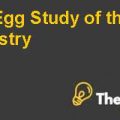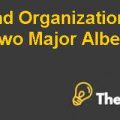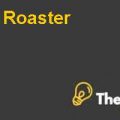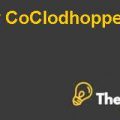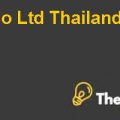ABSTRACT
Abercrombie & Fitch is one of the world’s major clothing retailers and they have a very strong brand name. They are currently operating in North America, Europe and Asia through 1,070 stores. Abercrombie & Fitch CEO, Mike Jefferies, expressed his decision to concentrate on expanding direct–to–customer business, international market and mortar stores, while shrinking the domestic operations by reducing numbers of stores domestically. The brand gained an appropriate growth in revenue in previous years but, in 2011, share price of Abercrombie & Fitch went down because they could not meet the projected estimates of Wall Street. It was an exciting situation for A&F Co. as they had to decide the focus strategy for their brand and which market segment they would target. To analyze the position of A&F Co. in the given scenario, recommended techniques and models for analysis are Porter’s Five Forces model to analyze the industry environment, driving force analysis and to counter macroeconomic and cultural issues, strategic group maping analysis in order to recognize the brand positioning, key success factor analysis along with SWOT analysis to examine the internal and external environment of A&F Co. To expand international market share, marketing strategies such as segmentation, targeting and positioning, and 4P analysis are the best technique available to A&F Co.
Introduction/ Background
Abercrombie & Fitch Co. is a successful name with specialty clothing retailer holding four unique lifestyle brands. A&F was established in 1892 and incorporated in Delaware in 1996, through its subsidiaries functions retail stores and direct-to-consumer business under the Abercrombie & Fitch, Abercrombie kids, Hollister Co. and Gilly Hicks brands. Abercrombie & Fitch (A&F) headquarter is situated in New Albany, OH. A&F has a successful history and did an excellent job by keeping up customer relationship and changing fashion. Just like during the World War II, the products were just customized with the war condition and they were consumed properly in the market.
Because of some internal and external issues, the company filed for bankruptcy in the year of 1977 and a year later Oshman’s sporting goods purchased Abercrombie & Fitch (A&F). After one year of acquisition, A&F Co. accounted a net profit of $1.5 million. The slogan was changed to “The Adventure Goes On”. Such rapid recovery happened due to the goodwill of A&F.
In 1988, Limited Inc. bought the company for $45 million and totally turned around the structure of A&F Co. and changed everything. Its focus was on clothes and less on sporting wears and introduced casual, classic American men and women’s wear. It changed the position the company as a provider of youth wear with specializing in the provision of outdoor clothing. In 1988, the company decided to review its marketing strategy in order to transform its representation to that of a luxury lifestyle brand and expand their number of retail stores with the idea of “Out went the camping gear- and off came the clothes”. As A&F Co. changed its strategy regarding its camping and sporting goods, hence, it also got rid of advertising clothed models. The brand came with new identification, provocative and sexually precise marketing campaigns and quarterly.
Abercrombie and Fitch announced its initial public offering on the New York Stock Exchange with the symbol “ANF” at US$16 per share on September 1996.
The CEO of A&F, Michael Jeffries was able to make transform the store concept and strategy as the place that match with the vacillating youthful needs and wants. A&F was positioned as the 4th profitable (net income as percentage of sales) company in wear retailers in 2006. A&F expanded its targeted market with the improved product development strategy so as to satisfy the demands of different life stage. The company changed its human resource policy for hiring new employee and now A&F Co. hires attractive and physically good looking men and women as these employees are their brand ambassadors as new marketing strategy in-store marketing. Currently, A&F is operating not only in United States but also in Asia, North America and Europe with the network of 1070 stores, which are doing business in four different products. One year sales and income growth for the year 2011 was 18.4% and 59066.5% respectively. The CEO of A&F came with new innovative strategies to counter the future problems and issues in order to expand its direct-to-customer business and target international market and mortar stores as well as shrink the stores network in United States. Major competitors of A&F are American Eagle Outfitters, Aéropostale, J. Crew, Gap Inc., Victoria’s Secret and other stylish brands targeting the younger consumer. In 2010, Abercrombie & Fitch accounted net sales of US$3.468 billion, Aéropostale accounted net sales US$2.4 billion, American Eagle accounted net sales US$2.97 billion, The Gap accounted net sales US$14.197 billion, J. Crew accounted net sales US$1.722 billion and Victoria’s Secret accounted net sales US$5.604 billion. In latest years, A&F Co. faced intense competition in the market .........................
This is just a sample partial case solution. Please place the order on the website to order your own originally done case solution.Abercrombie & Fitch Case Solution
With roots in sports and excursion goods, Abercrombie and Fitch Co (F & Co) has become one of the most famous men and women apparel retail brands in 2012. From the very beginning, and F is "stuck in (his) knitting is not trying to be all things to all people" and adopted the philosophy of creating a unique brand experience for each of its brands subsidiary. CEO faced with the decision to focus on the expansion of direct-to-consumer transactions and international brick and mortar stores, while closing stores in the domestic market. Brand was an increase in sales in recent years, but in 2011, saw shares fall after missing Wall Street's forecast estimates. & F Co. was in an interesting position -. The company had to decide where to focus their brand and market segment that would meet in the direction of "Hide
on Mahi Cameron, David Anderson, Boelsems Gracie, John Garrison Source: Richard Ivey School of Business Foundation 15 pages. Publication Date: November 28, 2012. Prod. #: W12342-PDF-ENG

